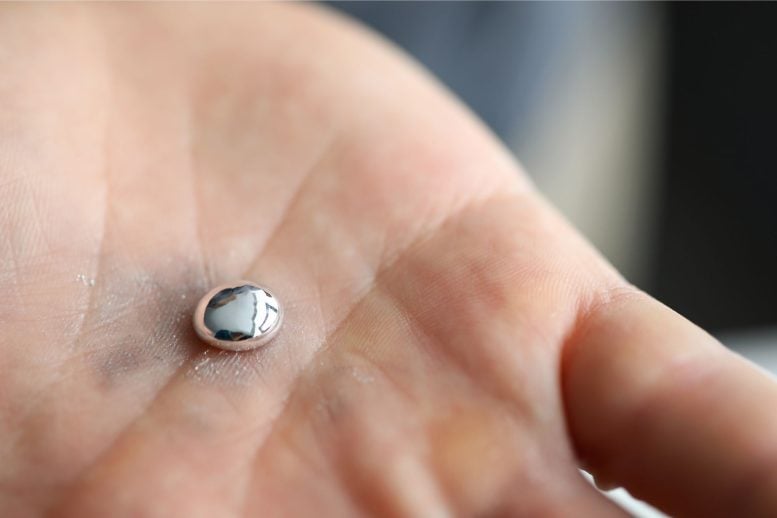
Scientists Discover New Properties of Unusual Metal
-
by Anoop Singh
- 13

New research reveals aspects of structure and behavior at the atomic level.
Nearly 150 years after its discovery and subsequent addition to the periodic table, gallium continues to reveal its secrets. Scientists from the University of Auckland have recently uncovered new aspects of the metal’s structure and behavior.
First identified in 1875 by French chemist Paul-Émile Lecoq de Boisbaudran, gallium is notable for its low melting point, which is so low that a spoon made from gallium can melt in a cup of tea. This unusual metal is also a crucial component in the manufacturing of semiconductors.
The surprising discovery relates to gallium’s behavior at the atomic level.
Unlike most metals, gallium exists in the form of `dimers’ – pairs of atoms – and is less dense as a solid than as a liquid, akin to how ice floats on water. Gallium features `covalent bonds’ where atoms share electrons, also unusual for a metal.
The new study shows that while those bonds disappear at melting point, they reappear at higher temperatures.
That contradicts long-standing assumptions and necessitates a new explanation for gallium’s low melting point. The researchers propose that the key may be a large increase in entropy – a measure of disorder – when the bonds disappear, freeing up the atoms.
Breakthrough in Understanding Gallium
“Thirty years of literature on the structure of liquid gallium has had a fundamental assumption that is evidently not true,” says Professor Nicola Gaston, of Waipapa Taumata Rau, University of Auckland and the MacDiarmid Institute for Advanced Materials and Nanotechnology.

The research was carried out by Dr Steph Lambie – now a postdoctoral researcher at the Max-Planck Institute for Solid State Research in Germany –Gaston and Dr. Krista Steenbergen, of Victoria University of Wellington and the MacDiarmid Institute.
The breakthrough came from Lambie, then a PhD student with the University and the MacDiarmid Institute, meticulously revisiting scientific literature from previous decades and comparing temperature data to piece together the complete picture.
Their findings were recently published in the scientific journal Materials Horizons.
Applications and Historical Significance of Gallium
Understanding gallium’s exact processes, and especially how it changes with temperature, is important for advances in nanotechnology, where scientists manipulate matter to create new materials.

The metal is used to dissolve other metals, facilitating the creation of liquid metal catalysts and `self-assembling structures,’ where disordered materials spontaneously become structured.
Zinc `snowflakes’ were created by crystallizing zinc in liquid gallium in a previous project involving Gaston, Lambie, and Steenbergen.
Gallium was predicted before it was discovered. When Dmitri Mendeleev, the Russian chemist, created the first periodic table in 1871, arranging the elements according to increasing atomic numbers, he left gaps for missing elements suggested by known elements.
Extracted from minerals and rocks such as bauxite, gallium isn’t found in nature in its pure form. Used in semiconductors, the metal also features in telecommunications, LEDs and laser diodes, solar panels, high-performance computing, the aerospace and defense industries, and as an alternative to mercury in thermometers.
Intriguingly, scientists hunting for traces of past life on Mars see potential for gallium to offer clues as a chemical `fingerprint’ preserving traces of past microbial life. Researchers in the University’s School of Environment and Te Ao Mārama – Centre for Fundamental Inquiry are investigating.
Reference: “Resolving decades of debate: the surprising role of high-temperature covalency in the structure of liquid gallium” by Stephanie Lambie, Krista G. Steenbergen and Nicola Gaston, 24 June 2024, Materials Horizons.
DOI: 10.1039/D4MH00244J
University of Auckland researchers have uncovered new properties of gallium, demonstrating that its covalent bonds, unique among metals, reappear at high temperatures, challenging long-held views and providing insights critical for nanotechnology and other fields. New research reveals aspects of structure and behavior at the atomic level. Nearly 150 years after its discovery and subsequent addition…
University of Auckland researchers have uncovered new properties of gallium, demonstrating that its covalent bonds, unique among metals, reappear at high temperatures, challenging long-held views and providing insights critical for nanotechnology and other fields. New research reveals aspects of structure and behavior at the atomic level. Nearly 150 years after its discovery and subsequent addition…
